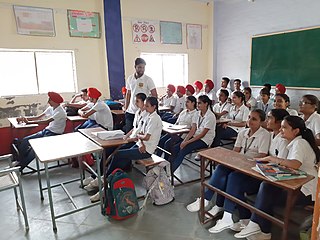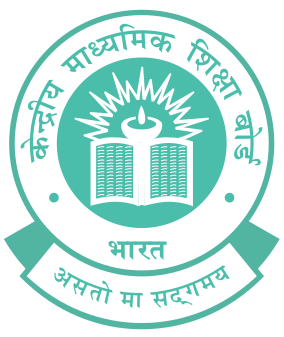
Education in India is primarily managed by state-run public education system, which fall under the command of the government at three levels: Central, state and local. Under various articles of the Indian Constitution and the Right of Children to Free and Compulsory Education Act, 2009, free and compulsory education is provided as a fundamental right to children aged 6 to 14. The approximate ratio of public schools to private schools in India is 7:5. Major policy initiatives in Indian education are numerous. Up until 1976, education policies and implementation were determined legally by each of India’s constitutional states. The 42nd amendment to the constitution in 1976 made education a ‘concurrent subject’. From this point on the central and state governments shared formal responsibility for funding and administration of education. In a country as large as India, now with 28 states and eight union territories, this means that the potential for variations between states in the policies, plans, programs and initiatives for elementary education is vast. Periodically, national policy frameworks are created to guide states in their creation of state-level programs and policies. State governments and local government bodies manage the majority of primary and upper primary schools and the number of government-managed elementary schools is growing. Simultaneously the number and proportion managed by private bodies is growing. In 2005-6 83.13% of schools offering elementary education were managed by government and 16.86% of schools were under private management. Of those schools managed privately, one third are ‘aided’ and two thirds are ‘unaided’. Enrolment in Grades 1-8 is shared between government and privately managed schools in the ratio 73:27. However in rural areas this ratio is higher (80:20) and in urban areas much lower (36:66).
The Secondary School Certificate, also called SSC or Matriculation examination, in madrasah education Dakhil is a public examination in India, Bangladesh and Pakistan conducted by educational boards for the successful completion of the secondary education exam in these countries. Students of 10th grade/class ten can appear in these. It is equivalent to GCSE in England and first two years of high schools in United States.
Tenth grade or grade 10 is the tenth year of school post-kindergarten or the tenth year after the first introductory year upon entering compulsory schooling. In many parts of the world, the students are 15 or 16 years of age, depending on when their birthday occurs. The variants of 10th grade in various countries are described below.

Education in Bangladesh is overseen by the country's Ministry of Education. The Ministry of Primary and Mass Education is responsible for implementing policy for primary education and state-funded schools at a local level. In Bangladesh, all citizens must undertake ten years of compulsory education which consists of five years at primary school level and five years at high school level. Primary and secondary education is financed by the state and free of charge in public schools.
Udayan Higher Secondary School Dhaka, formerly known as Udayan Bidyalaya is a private higher secondary school in Bangladesh, established in 1955 by the University of Dhaka. It is a co-educational institution.
In India, board examinations refer to the public examinations that are conducted at the end of the 10th grade education (SSC), and at the end of the 12th grade education (HSC). The scores achieved in these exams are considered very important for getting into universities, professional courses or training programmes and other occupations.
Madhyamik Pariksha or simply Madhyamik is a centralised examination conducted by the West Bengal Board of Secondary Education in West Bengal, India, at the end of the 10th standard of high school. Similarly one examination is also conducted at the state of Tripura for its students studying in Govt or Govt Aided school under the control of Tripura Board of Secondary Education. By count of examinees, it is among the better known 10th standard examinations in India. In WBSE, Over 600,000 students took the exam in 2000, and the number has increased substantially since then. The number of students reached a record 1 million in the 2011 Madhyamik examination. Compulsory subjects are first language, second language, physical science, life science, mathematics, history and geography.
The Higher Secondary Certificate (HSC) is a public examination credential in Bangladesh, India, and Pakistan. HSC is equivalent to GCE A Level in England and 3rd and 4th year of high schools in the United States.
Our Lady of Fátima High School is a Catholic school in Aligarh, Uttar Pradesh, India, affiliated to the Central Board of Secondary Education board located at Ramghat Road, Aligarh. The principal is Sr. Jyotsana.

Rochambeau The French International School of Washington DC is a private French international school in Montgomery County, Maryland, near Washington, D.C. It maintains its administrative headquarters and its secondary campus in Bethesda, a preschool campus in Bethesda, and an elementary school in Chevy Chase. Circa 2022 preschool and elementary grades will relocate to a new campus in Bethesda.
Indian School Al Wadi Al Kabir (ISWK), established in 1978, is located in the city of Muscat, Oman. The school was founded by Founded in 1941 as a Gujarati Medium School for the children of the members of the business community. Mr. Lobo was principal of the school since 1990 to spring 2008. Later there was another principal Mr.P.N.Ashok who resigned in 2012. The present principal is Mr. D. Nageswar Rao.

The Central Board of Secondary Education (CBSE) is a national level board of education in India for public and private schools, controlled and managed by the Government of India. Established in 1929 by a resolution of the government, the Board was indeed a bold experiment towards inter-state integration and cooperation in the sphere of secondary education. There are approximately 26,054 schools in India and 240 schools in 28 foreign countries affiliated to the CBSE. All schools affiliated to CBSE follow the NCERT curriculum especially from class 9 to 12. The current Chairperson of CBSE is Vineet Joshi IAS.
Islamia English School, abbreviated as IES, is an English Medium School located in the Al-Dhafra neighborhood of Abu Dhabi. It was rated as satisfactory by the ADEC. The majority of the students are children of Pakistani expatriates living in Abu Dhabi, with significant minorities of Indian, Bangladeshi, and Arab students as well. IES is managed by a board of directors and partners, predominantly housed by members of the Darweesh family and descendants of the three founding partners. IES was founded by Founder Chairman, the late Darweesh Benkaram, founder Vice-Chairman, late Dr. Shamsudeen Hashmi, and Founder-Director, late Muhammad Arif Khan. It was founded on the principle of providing easily accessible and reasonably priced education for children of sub-continent students.
All India Secondary School Examination, commonly known as board exams, is a centralized public examination that students in schools affiliated with the Central Board of Secondary Education in India take after class 10. The board conducts the examination during the period of February every year even after implementing the ambitious project of Continuous and Comprehensive Evaluation. Now that the board has ended the Continuous and Comprehensive Evaluation pattern as a result Joint Employment Test, NEET, etc., the exam is conducted by the National Testing Agency instead. In this exam, Mathematics, Science and S.St are compulsory with any two languages. Students can also opt skill subject such as information technology, painting, yoga, music or artificial intelligence. Successful candidates are awarded the Secondary School Completion Certificate, a Statement of Marks, and a Migration Certificate stating that the candidate has completed Secondary Schooling and can pursue higher education. For the 2016-17 academic year, the Central Board of Secondary Education has revived the old system of syllabus and marking scheme India has state exams and central exams.
The education system in Lahore is formulated along specific modern, religious, cultural, social, psychological, commerce and scientific injunctions. Lahore is Pakistan’s largest producer of professionals in the fields of science, technology, IT, engineering, medicine, nuclear sciences, pharmacology, telecommunication, biotechnology and microelectronics. Most of the reputable universities are public, but in recent years there has also been an upsurge in the number of private universities. The current literacy rate of Lahore is 64%. The standard national system of education is mainly inspired from the British system. The system also aims to imbibe a secular outlook among the students with the awareness of the rich cultural heritage of Pakistan. Lahore has a wide range of schools, colleges and universities that caters to diverse streams.

Tamil Nadu is one of the most literate states in India. The state's literacy rate is 80.33% in 2011, which is above the national average. A survey conducted by the Industry body Assocham ranks Tamil Nadu top among Indian states with about 100% Gross Enrollment Ratio (GER) in primary and upper primary education.
Narayanganj High School & College, is one of the oldest educational institutions of Narayanganj. Since its establishment in 1885, Narayanganj High School served the motherland in many ways.
A high school diploma is a North American academic school leaving qualification awarded upon high school graduation. The high school diploma is typically obtained after a course of study lasting four years, from grade 9 to grade 12. The diploma is awarded by the school in accordance with the requirements of the local state or provincial government. Requirements for earning the diploma vary by jurisdiction, and there may be different requirements for different streams or levels of high school graduation. Typically they include a combination of selected coursework meeting specified criteria for a particular stream and acceptable passing grades earned on the state exit examination.





